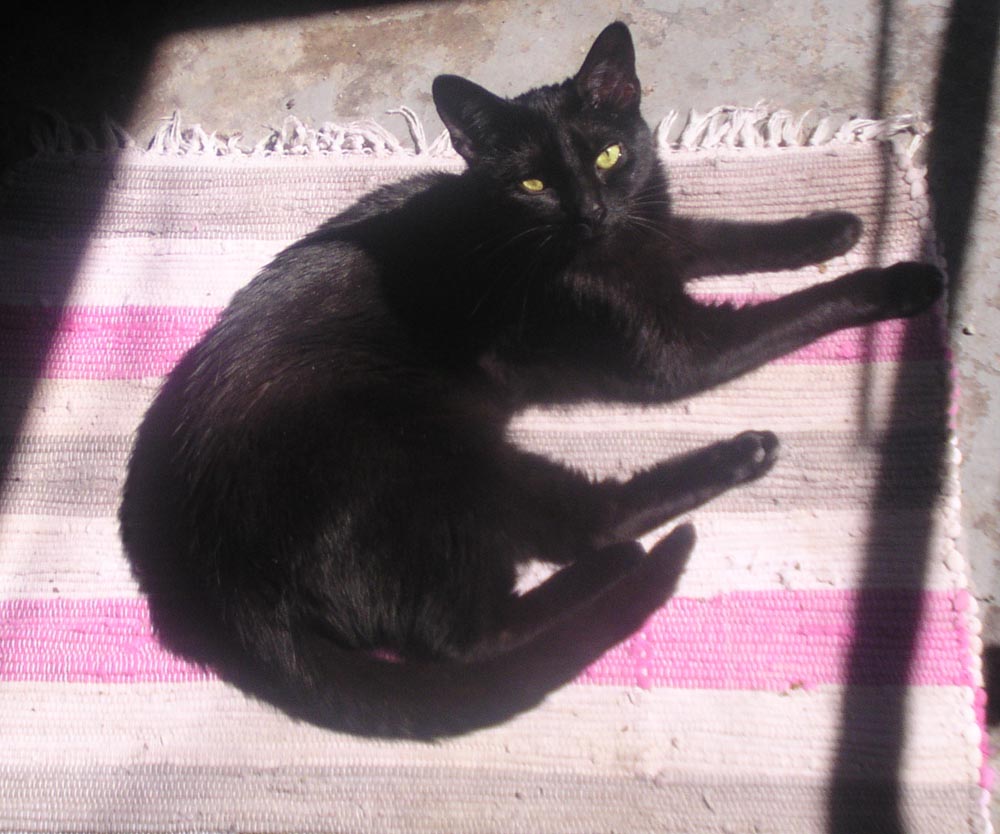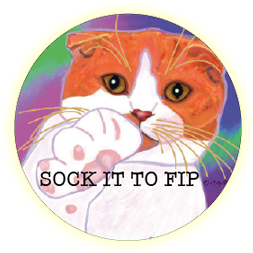UC Davis FIP Study Seeks DNA Samples

When I’ve mentioned the black kitten Lucy, half-sister to the Four and one of Mimi’s earlier daughters, I also mention a study of feline infectious peritonitis (FIP) in which her DNA, and that of her mother and siblings and the Four, is included. That study is still active, and still looking for DNA submissions for cats positively diagnosed with FIP as well as other related cats.
The program is called “SOCK-FIP”, an acronym for “Save Our Cats and Kittens from Feline Infectious Peritonitis”. In 1974, Save Our Cats and Kittens (SOCK) was organized as a nonprofit group founded by cat lovers from the San Francisco Bay Area to aid in much-needed feline leukemia virus (FeLV) research at the UC Davis School of Veterinary Medicine.FeLV infection was the cause of death of up to one-third of all sick cats during the 1960s and 1970s. “SOCK-FIP” is a part of that group dedicated to eliminating Feline Infectious Peritonitis (FIP) through advocacy, community education and financial support for UC Davis-CCAH FIP Research. The group shares information to other FIP studies around the US and around the world.
The study is seeking DNA samples from cats that have been positively diagnosed with FIP, closely related individuals, as well as cats from lines that definitely have not been affected by FIP. DNA samples are easy to collect—just vigorously swab the inside of the cat’s cheek with one end only of a Q-Tip, then let the swab air-dry at room temperature. Put the dry swab in a paper envelope and send to UC Davis along with the completed DNA submission form. Full instructions for swabbing and storing and completing submission forms can be found on the SOCKFIP.org web site at: http://www.sockfip.org/fip-studies.html
Submit DNA Samples and Forms to:
Niels C. Pedersen, DVM, PhD
Center for Companion Animal Health
School of Veterinary Medicine
University of California- Davis
One Shields Avenue
Davis, CA. 95616-8782
SOCK-FIP and Dr. Neils Pedersen
SOCK-FIP is directed by Dr. Neils Pedersen, DVM, PhD, one of the country’s leading researchers in FIP. Until 2013 he was Executive Director of the Center for Companion Animal Health and Director of the Veterinary Genetics Laboratory when he retired to concentrate on FIP research and collaboration. He is hands-on with his team of researchers and even returns phone calls from inquisitive pet owners. When I prepared my DNA samples from Mimi and the Four as well as Lucy’s full sister Charlotte I wondered if there was any way to gather DNA from the snippet of Lucy’s fur I had or even her cremains, so I called and left a message—in the days before email was so convenient. Dr. Pedersen himself returned my call and explained that hairs alone include only mitochondrial DNA, while the follicle includes the nuclear DNA needed for inclusion in the study.
Learning about FIP
I had heard about Feline Infectious Peritonitis, or FIP, before Lucy’s diagnosis. With the overcrowded shelters of the 1980s and the awareness of Feline Leukemia Virus, or FeLV, in that decade, we had suddenly learned of a whole alphabet soup of diseases that could kill our cats, and there was no known cure, even the transmission wasn’t easily understood. We had actually gotten a grip on FeLV, FIV, Feline Aids and related diseases, but FIP continued, and still continues to, elude researchers in how it mutates into the deadly form, why some exposed cats seem to be immune, and how it can be treated, even cured.
FIP kills up to 1 in 100 cats under age 5, and cats coming from more crowded or stressful situations such as shelters or catteries are at five to 10 times greater risk of contracting and developing the disease. It is virtually 100% fatal, meaning no cats have been known to survive for more than a few months beyond diagnosis without symptoms, and while a vaccination has been developed it is hardly effective enough to make it worth the effort and risk, symptoms can be treated but the treatment is palliative, not curative, and so there is no treatment or cure.
FIP begins as Feline Enteric Coronavirus, or FECV. A coronavirus, in short, replicates itself by invading the actual cells of a mammal or bird species so that it replicates as a part of each cell and the host’s body may not recognize the infection and often doesn’t fight it. By contrast, a cold or influenza virus simply embeds itself somewhere in the body and begins breeding in tissue such as mucous membranes of the sinuses or lungs while the body sets up an immune response to what is clearly an invader. A complication is that FIP may sit dormant for weeks to years with only vague symptoms or no symptoms at all before it manifests, one of the things that makes it so difficult to diagnose.
About 90 percent of cats who come in contact with FECV have only minor symptoms or develop other diseases which can be treated. It’s what happens to the other 10% after the initial invasion of FECV that makes it the deadly FIP—the virus somehow—and that’s what’s currently being studied—somehow mutates within the cat’s own body into FIP, and the mutation is apparently different for each cat, even among siblings, which is what prevents setting up a standard treatment or formulating a vaccine. It’s currently suspected that a genetic factor causes or allow it to mutate into the deadly form.
There are two forms of FIP, referred to as granulomatous, or dry, FIP and effusive, or wet, FIP; the first has no apparent symptoms though it leaves characteristic lesions on internal organs, the second form causes fluids to build up in the abdominal or pleural cavity, which is what I saw in Lucy near the end of the two weeks of symptoms leading up to her diagnosis. This fluid can be drained but will usually return, and the fluid itself puts a strain on the body’s function, as Lucy had trouble breathing and no doubt it put a strain on her heart, and on the immune system. The dry form has little to no fluids developing in the body, but lesions develop on the internal organs and these lesions variously affect the organ’s function and lead to secondary infection.
I was relieved to find that FIP itself, because of the nature of the coronavirus mutation, wasn’t “laterally transmissible” from one cat to another, meaning Lucy couldn’t pass FIP directly to another cat, so she hadn’t infected my household, though she could transmit FECV and I would have to observe the others to see if anything would develop (nothing ever has). The disease is only transmissible by contact with the feces from an infected cat, and it could be carried on fur and clothing, surviving for up to two weeks after the feces were passed, but because the disease could sit dormant for a period of time it was hard to tell where she might have picked it up. I have ten litterboxes in my house, and every so often one of the older cats, especially as they had come near their end, had had accidents. All my cats have been rescues, coming in contact with everything nature had to offer, any one of them could have been a carrier of sorts. For that reason, when I decided to take in Mimi and her babies, I not only cleaned the entire house but waited three weeks just to be safe.

ABOUT THE SOCK-FIP LOGO
From the website: This sweet, loving little kitten, Lucy, was adopted at four months of age by the Sanchez family.The family adored her, but, tragically, Lucy died of FIP two months later.Claudia Sanchez, the artist, drew this portrait of Lucy as Lucy reached out with her tiny paw.The Board of Directors of SOCKFIP were so moved by Lucy’s story and Claudia’s rendering of her cat that we adopted Lucy as the cat in our logo.
I’ve always been secretly pleased that the kitty in the logo is named “Lucy”.
SOCK FIP, http://www.sockfip.com/, the official page of the genetic study of FIP at the University of California at Davis led by Dr. Niels C. Pedersen. This site explains as much about FIP as the researchers know and is regularly updated with information. They also accept DNA in the form of cheek swabs from cats who have FIP or who are related to cats with FIP, and the data gathered from the DNA is entered into the study. They are especially interested in freely-bred cats who pass genetic information randomly in addition to cats bred at catteries.
Read more articles about Health and Safety and Veterinary Medicine.
Browse some rescued cats and kittens!
All images used on this site are copyrighted to Bernadette E. Kazmarski unless otherwise noted and may not be used without my written permission. Please ask if you are interested in using one in a print or internet publication. If you are interested in purchasing a print of this image or a product including this image, check my Etsy shop or Fine Art America profile to see if I have it available already. If you don’t find it there, visit Ordering Custom Artwork for more information on a custom greeting card, print or other item.
Do you appreciate the stories and images we offer you each day?
© 2014 | www.TheCreativeCat.net | Published by Bernadette E. Kazmarski
—
Weekly schedule of features:
Sunday: Essays, Pet Loss, Poetry, The Artist’s Life
Monday: Adoptable Cats, TNR & Shelters
Tuesday: Rescue Stories
Wednesday: Commissioned Portrait or Featured Artwork
Thursday: New Merchandise
Friday: Book Review, Health and Welfare, Advocacy
Saturday: Your Backyard Wildlife Habitat, Living Green With Pets, Creating With Cats
And sometimes, I just throw my hands in the air and have fun!
—


